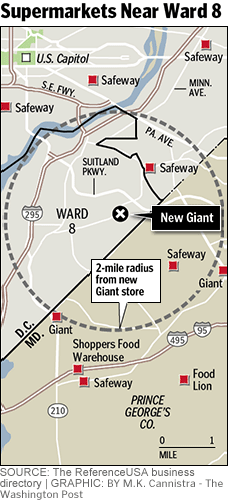Do we need a grocery ambassador or a city-wide food security/foodways plan?
In the round of the zoning update on food issues, I didn't see fit to submit comments about urban agriculture, even though I guess I should have. Evidently, it's still gonna be close to impossible to have poultry, not to mention there is little discussion of urban orchards, urban forestry, and other issues, even though people are concerned about "food deserts" and access to fresh foods.
According to the Washington Business Journal, in Cheh introduces "grocery ambassador" bill, Councilmember Mary Cheh has introduced legislation on the topic, calling for a grocery czar amongst other steps, but I think the legislation is somewhat narrowly conceived because this issue is about more than just trying to attract some grocery stores.
The real issue is a comprehensive plan for food security and foodways in the city. Grocery stores are but one piece.
The Community Food Security Coalition is an organization broadly focused on food access. Toronto and a number of other communities across North America have created "Food Policy Councils" to focus on food access at the local level, especially in urban places, and work to make more direct links between urban and rural food policy. (The book The Edible City looks broadly at Toronto's foodways, food policies, and food industries. This paper, Food Policy Councils: The experience of five cities and one county, from 1994 discusses the disconnection of cities from foodways policymaking.)
Food Trust in Philadelphia has pushed food security and initiatives to increase the availability of fresh foods and supermarkets in underserved areas in the city and state.
Finally, the Economic Research Service of the USDA has created a Community Food Security Assessment Toolkit which provides a more systematic method for evaluating community food security and a planning framework for improvements.
The issue is tricky.
First, there is a conceptual problem with the food desert issue, because of how new urbanists and such are defining the need for access--a grocery store within easy walking distance--and the reality of how the supermarket industry is organized and focused on providing stores of 50,000+ square feet, serving retail trade areas of 50,000+ residents in a retail trade area five miles in diameter.
The reality is that not every neighborhood is large enough to support a full line grocery store the way that the grocery industry is set up to "deliver" supermarkets. Plus, many people are cost-conscious and end up patronizing stores where prices are lower (as opposed to smaller neighborhood-based stores). And the industry has worked hard at closing smaller, neighborhood stores in favor of larger single stores serving many neighborhoods.
Second, there are many grocery stores accessible to DC residents in neighborhoods that are seemingly understored, but the stores happen to be located just outside of the city in Maryland.

Washington Post image from the 2007 article "Signs of Change Line the Shelves."
Third, we need to look at farmers markets and public markets more systematicaly as a way to deliver fresh foods to residents, not so much in the higher-income areas of the city, but in the "food desert" areas. Although these areas are hard places to make such markets work if their prices are higher than typical supermarket prices.
Fourth, plus working with store sizes significantly smaller than 50,000 s.f. and with extant companies, from corner stores to affiliates of Murray's stores, and companies that aren't necessarily the region's largest supermarket chains, and independents--finding companies that are innovative and able to understand the center city as a market that is distinct and different from the suburbs.
I don't know why it is so hard in the U.S. to find a company like Sobey's, one of Canada's more innovative suprmarket companies, with a couple divisions focused on center city locations. See "How Sobey's is taking on Loblaws" from the Toronto Globe & Mail and "Grocery chains develop a taste for urban living" from the Toronto Star.
Fifth, related to both 3 and 4 concerns how such entities are organized. A faux "public market" with 10-15 different vendors, along the lines of how Baltimore's Belvedere Square is organized, is a way to assist the development of retail entrepreneurialism as well as extend food access by working with smaller entities to offer "departments" within a common space, where the overall effect is the creation of a complete array of food offerings, but through multiple businesses rather than only one.
Sixth, not to mention nutrition education. The issue isn't merely access to nutritious food, but actually purchasing and eating such food. For a number of years, I have recommended that demonstration-teaching kitchens be incorporated into Eastern Market and Florida Market, as a way to teach better nutrition.
Seventh, plus urban agriculture, including community gardening, orchards, and forestry.
-----
I suppose I just put myself out of the running for the grocery ambassador position...
Labels: food-agriculture-markets, public health



0 Comments:
Post a Comment
<< Home